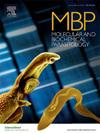Biological and physiological changes of Biomphalaria glabrata infected by Heterorhabditis bacteriophora
IF 1.5
4区 医学
Q4 BIOCHEMISTRY & MOLECULAR BIOLOGY
引用次数: 0
Abstract
The present study investigated for the first time the influence of exposure time (24 or 48 h) of Biomphalaria glabrata (Gastropoda: Pulmonata) to Heterorhabditis bacteriophora (Rhabditida: Heterorhabditidae), strain HP88, on some physiological and reproductive parameters of the host mollusk. Throughout the experiment, intense glycogenolysis was observed in both exposed groups, which was more accentuated in the digestive gland. This change was accompanied by a significant increase in the free glucose content in the exposed snails, indicating that H. bacteriophora infection induces the breakdown of host glycemic homeostasis. In parallel, significant variations in lactate dehydrogenase activity in the hemolymph of B. glabrata exposed to entomopathogenic nematodes were observed, confirming the transition from aerobic to anaerobic metabolism in the hosts. This physiological scenario contributed to the establishment of the parasitic castration process in this interface, compromising the reproductive performance of host snails, suggesting the use of H. bacteriophora HP88 as a potential alternative for control of B. glabrata.
光秃生物phalaria感染噬菌体异habditis后的生物学和生理变化
本文首次研究了腹足目:肺足目(Gastropoda: Pulmonata)暴露于菌株Heterorhabditis bacteriophora (rhabdida: heterorhabditida: heterorhabdititidae) HP88的时间(24或48 h)对寄主软体动物某些生理和生殖参数的影响。在整个实验过程中,两个暴露组均观察到剧烈的糖原溶解,且在消化腺中更为明显。这种变化伴随着暴露的蜗牛体内游离葡萄糖含量的显著增加,表明嗜杆菌感染诱导了宿主血糖稳态的破坏。与此同时,暴露于昆虫病原线虫的光斑拟南蝽血淋巴中乳酸脱氢酶活性也发生了显著变化,证实了宿主的代谢从有氧向无氧的转变。这一生理情景促成了该界面寄生去势过程的建立,影响了寄主蜗牛的繁殖性能,表明利用H. bacteriophora HP88作为控制光斑螺的潜在替代方案。
本文章由计算机程序翻译,如有差异,请以英文原文为准。
求助全文
约1分钟内获得全文
求助全文
来源期刊
CiteScore
2.90
自引率
0.00%
发文量
51
审稿时长
63 days
期刊介绍:
The journal provides a medium for rapid publication of investigations of the molecular biology and biochemistry of parasitic protozoa and helminths and their interactions with both the definitive and intermediate host. The main subject areas covered are:
• the structure, biosynthesis, degradation, properties and function of DNA, RNA, proteins, lipids, carbohydrates and small molecular-weight substances
• intermediary metabolism and bioenergetics
• drug target characterization and the mode of action of antiparasitic drugs
• molecular and biochemical aspects of membrane structure and function
• host-parasite relationships that focus on the parasite, particularly as related to specific parasite molecules.
• analysis of genes and genome structure, function and expression
• analysis of variation in parasite populations relevant to genetic exchange, pathogenesis, drug and vaccine target characterization, and drug resistance.
• parasite protein trafficking, organelle biogenesis, and cellular structure especially with reference to the roles of specific molecules
• parasite programmed cell death, development, and cell division at the molecular level.

 求助内容:
求助内容: 应助结果提醒方式:
应助结果提醒方式:


